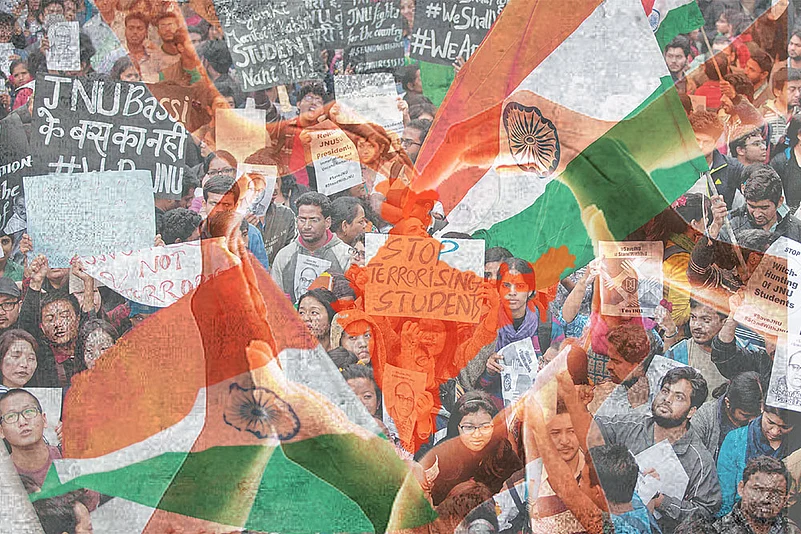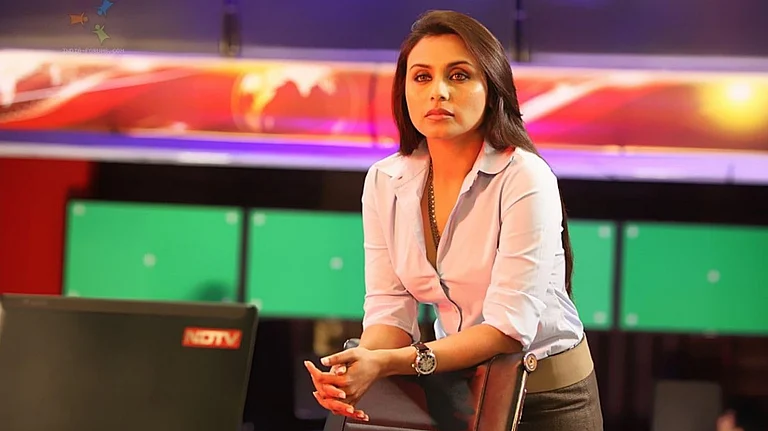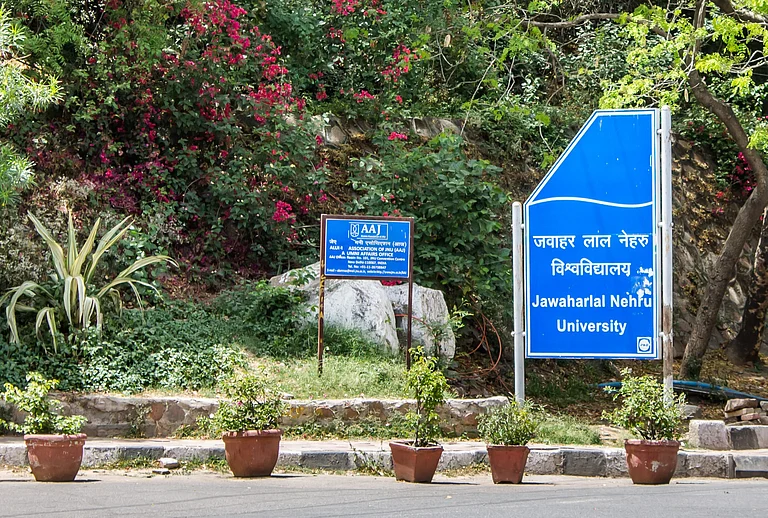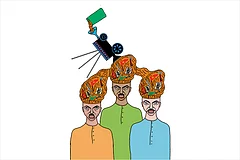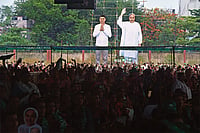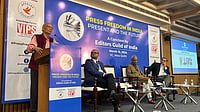“JNU jhukega nahi (saala),” Dhananjay, the newly elected president of the Jawaharlal Nehru University Student Union, proclaims with a mischievous smile when asked about the upcoming film JNU: Jahangir National University. Its teaser was released last month with the tagline—“Behind closed walls of education brews a conspiracy to break the nation.” The student leader also mimics the trademark palm under the chin move by actor Allu Arjun as he utters the defiant dialogue in the film Pushpa: The Fire.
Once known and ridiculed for speaking in academic jargon and remaining stuck in Soviet-era ideological conundrums, the “Kremlin on the Jumna” has taken effortlessly to Bollywood-speak at a time when a polarising depiction of it in popular culture has once again brought it into the spotlight, ahead of general elections being seen as momentous in the nation’s modern history.
Actor-singer-lyricist Piyush Mishra is the most well-known face of the campus-based drama, along with Ravi Kishan and Vijay Raaz. “Poonjivad se mujhko daraate ho kyun? Mujhko Lenin ke sapne dikhate ho kyun? (Why do you scare me about capitalism, why do you show me dreams of Lenin?)” Mishra proclaims from a stage modelled on JNU’s chaat-sammelan, an annual Holi event in which anyone can come and entertain the audience with funny speeches and satire.
Though the teaser and a song performed by Mishra—a parody of Habib Jalib’s legendary anti-establishment verse Main nahi manta—did manage to trigger the expected flurry of outrage and support on social media, the lanes of the South Delhi-based campus— these days full of blooming bougainvillea and students rushing for mid-term examinations—are by now used to the clamour that has rung out against the University over the past eight years.

The JNU north gate, where TV vans would descend at the slightest hint of disturbance during student protests on different issues and the police response, is shut as a handful of students stage a sit-in with daflis and shout slogans over an incident of sexual harassment on campus, alleging institutional apathy and erosion of an environment traditionally known as among the safest for women.
Much has changed and yet a lot has remained the same in JNU in the last few years, since it became the centre of a nationwide media frenzy in 2016, targeted not just by a section of the national political leadership but also by several media outlets, as a hub of “anti-national” activities. The teaser of the deliberately eponymous film, written and directed by Vinay Sharma, uses terms such as “pro-terrorism” and “criminal conspiracy”.
Much has changed and yet a lot has remained the same in JNU in the last few years, since it became the centre of media frenzy in 2016.
JNU has been in the news since the 1970s-80s, starting with the days of the Emergency, but from 2014-16, there has been a concerted attempt to portray it in a certain way, says Ajay Gudavarthy, associate professor at the Centre for Political Studies at the university. However, he questions the logic of painting the entire university with a single brush. “There is complete space for diversity of voices (on campus). For anybody who disagrees with the ‘dominant narrative’ of JNU, the intelligent thing to do would have been to make a dialogic, academic intervention,” he adds.
However, the film and other mainstream media depictions of the campus not only target its student politics but also the very existence of a public-funded space for research in humanities and “intellectualism” where scholars are offered scholarships and facilities for long durations to analyse and question government policies and society and engage in debate that could appear controversial. “Intellectuality hain jhuthi baatein badi, main nahi manta!” (intellectualism is false, I do not endorse it!) sings Mishra, a self-confessed communist in his youth who has taken a sharp anti-Left stance in his recent interviews and an autobiography.
“Now the debate has shifted to: Do we even need public-funded universities? The long-term result of turning the public perception against universities like JNU would make them equivalent to the government schools of the day so that students do not want to attend them, and are ready to shell out hefty fees for private research universities that have become prominent in recent years,” argues Jey Sushil, a US-based researcher, journalist and former JNU student who has penned a memoir about the campus in Hindi.
According to others, the shift has already started, as many high-ranking scholars of humanities are now making a beeline for private universities and there has been a major spike in students applying for PhD positions overseas, especially in Europe and the US. However, it may be too soon to sound the death knell for a university that has consistently topped the government’s own National Institutional Ranking Framework (NIRF). It remains one of the few research universities that are accessible to students across classes and identities with its nominal fee, and reservations for the OBC from 2009 onwards have resulted in a surge of a new section of students gaining access to higher education and research for the first time.
“I have had to struggle a lot to reach JNU, I had never imagined I would be able to pursue PhD here,” shares Namrata Pal, a PhD scholar at the Centre for Women’s Studies and a member of the Birsa Ambedkar Phule Students Association (BAPSA). She says that students from marginalised identities have struggled to explain the importance of the university in their lives and careers, following its branding as a den of politicking and conspiracies.
Brahma Prakash, an assistant professor at the School of Arts and Aesthetics, partially blames the “discomfort” of a section of the intelligentsia with the growing presence of students and faculty from marginalised sections for the narrative that JNU is now “done and dusted” and free-speech and quality research have moved to swanky campuses situated on the outskirts of the NCR and other major cities. He insists that the new-found diversity of the campus is unparalleled in its history and is generating discourse and articulation that is both dynamic and important.
On the other hand, the lack of modern infrastructure and facilities, as well as alleged administrative interference in faculty appointments, speaks of long-standing neglect and has triggered claims that this is a deliberate ploy to undermine the university.
Both Brahma Prakash and Sushil concur that some of India’s top social scientists and academicians, who once both prided themselves on running the show at public universities and benefitted from the intellectual capital this entailed, have virtually “abandoned” them for greener pastures and under pressure from a hostile establishment.
On the positive side, the relentless scrutiny and media backlash have forced the various ideological groups on the campus to join ranks and establish a dialogue. In the recently held student union elections, a coalition of Left groups won three out of the four seats of the central panel, while the fourth–the general secretary post–went to BAPSA after the left-candidate was disqualified and unilaterally declared support for the BAPSA candidate. The Akhil Bharatiya Vidyarthi Parishad (ABVP), perceived as the student wing of the BJP, stood second on all seats, with the contest turning out to be less close than it earlier appeared in elections that were held after a four-year hiatus.
“All these groups came together because of the breathing-down of the Right,” says Gudavarthy, although he warns that the level of political discourse on campus has gone down, as the focus shifted to hard political realities of polarisation, rather than theoretical debates.
With A student strength of about 9,000—up from 5,500 in 2009—JNU has always punched above its weight in the national discourse.
Dhananjay, the first Dalit president of the JNU Student Union in over two decades, says that what puts JNU in the crosshairs of the government is its constant intervention in crucial political debates and sharp criticism of policies that he dubs as anti-people. “They are afraid of us because we have led many massive protests and stood in solidarity with farmers and other protesting groups.” Sitting at the iconic Ganga Dhaba, the site of many such protests and late-night debates, the young man from Bihar’s Gaya district appears almost too well-rehearsed in his defence of the campus.
JNU remains embattled, but within its boundaries; it continues in its parallel world, of term papers and presentations, examinations and dissertations. A Centre for Law and Governance scholar is caught completely unaware of the new movie, having remained relatively cut off from social media and its short-lived sensations and “viral” causes. Another passerby, a former student visiting campus with his partner—who is attending a conference—makes a face when asked to react to the film, saying he did not even want to think about it or respond to it.
With a student strength of about 9,000—up from around 5,500 in 2009—this 1,000-acre campus has always punched above its weight in the national discourse, leading to contrasting claims of a revolutionary legacy or being given undue importance and clout. However, more than anything else, it has been unique in the curious blend of students, courses, backgrounds and ideologies that it brings together. Having produced some of the most well-known names in humanities, it also houses institutions of scientific and educational research, with historians rubbing shoulders with experts in biotechnology in the hostels and dhabas.
A residential campus results in an atmosphere that provides a much-needed cushion from the pressures and distractions of daily life in order to focus on academics and theories. This is a luxury and a privilege accorded to a few, and has irked many who see it as unnecessary and wasteful in a technology and corporate-driven world, where material production is seen as the sole criterian of productivity.
“For a country like India, with humongous social gaps, the interests and imagination of different classes about what a nation should be are almost mutually exclusive. The success story of a public institution like JNU is that it puts them together in a heterogeneous space and forges a dialogue between them,” concludes Gudavarthy.
MORE FROM THIS ISSUE
However, as the film hits the cinemas in April amid the elections—its initial release on April 5 having been postponed—the verdict is not out. Whether JNU—turned into a symbol of anti-establishment politics since 2014—will be able to justify its existence to a public that largely takes its cues from WhatsApp and TV remains to be seen. It is this section of society that is often at a loss to understand why a few young men and women, caricatured as bearded jhola-wallas and conspiring vamps, continue to raise uncomfortable and downright “objectionable” questions.
(This appeared in print as 'Just Not Understood'.)






